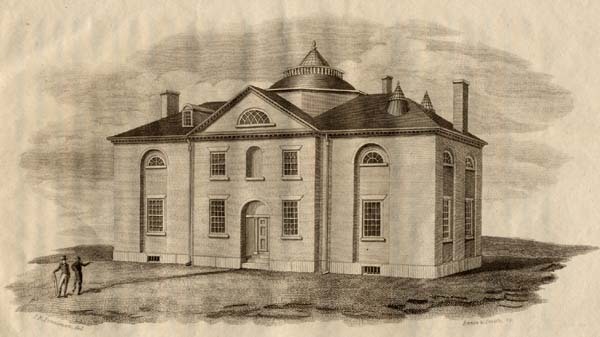The School on Mason Street
Harvard began to flourish in Boston, and the number of its graduates as well as the number of students matriculating in the school increased. The four graduates of the Class of 1812 were succeeded by twelve in the following year, and the number of graduates fluctuated between twelve and twenty over the next decade, and then from twenty to fifty until the outbreak of the Civil War. There were seventy-five matriculants in 1815. While most students were from the New England states, there was one from Maryland and another from the District of Columbia. By the mid-1830s, there were over one hundred matriculants in the school, including students from Nova Scotia, Louisiana, and Cuba.
The success of the Medical School and the growing number of its students prompted another move. The Harvard Corporation, at the instigation of the Medical Faculty, petitioned the Massachusetts state legislature for funds to build an adequate home for the school. The Faculty received a grant of $18,000 to obtain land and erect the first structure specifically for its needs, a brick building on Mason Street, near Boston Common. The new facility opened in 1816, and while the Medical School prospectus described it as "large and handsome…. Its apartments are spacious and convenient," the structure measured only 83 feet long and 43 feet wide. The Mason Street building did include two amphitheater-style lecture halls, an anatomical theater, chemical laboratory, dissecting rooms, and a 3,000 volume library, and its interior was illuminated by a skylight. Because of the state funding for its construction, the building was often referred to as the "Massachusetts Medical College." Harvard would occupy the Mason Street building for the next twenty years.
Changes continued in the Medical School's faculty as well during the period on Mason Street. A new professorship in midwifery and medical jurisprudence was authorized in 1818, and materia medica was divided from chemistry in 1824. A professorship in the principles of surgery and clinical surgery was added in 1835, bringing the number of professorships to six, along with a demonstrator in anatomy, adjunct professors, a sub-librarian, and lecturers in specific subjects. This academic structure would endure until 1847, when separate professorships in pathological anatomy and anatomy and physiology were created. This period also saw the first administrative organization of the Medical School with the appointment of John Collins Warren as dean, a new office created in 1816 to oversee the institution and its faculty.

